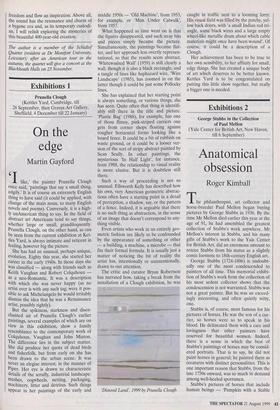Exhibitions 1
Prunella Clough (Kettles Yard, Cambridge, till 26 September, then Graves Art Gallery, Sheffield, 4 December till 22 January)
On the edge
Martin Gayford
Ilike,' the painter Prunella Dough once said, 'paintings that say a small thing, edgily.' It is of course an extremely English thing to have said (it could be applied, with change of the main noun, to many English novels and poems). Conversely, it is a high- ly unAmerican thing to say. In the field of abstract art Americans tend to say things, whether large or small, grandiloquently. Prunella Clough, on the other hand, as can be seen from the current exhibition at Ket- tles Yard, is always intimate and reticent in feeling, however big the picture.
She has had an unusual, perhaps unique, evolution. Eighty this year, she started her career in the early 1940s. In those days she was classified — along with friends such as Keith Vaughan and Robert Colquhoun as a neo-Romantic. It was a description with which she was never happy (as no artist ever is with any such tag; were it pos- sible to ask Michelangelo he would irritably dismiss the idea that he was a Renaissance artist, possibly rightly).
But the spikiness, starkness and disen- chanted air of Prunella Dough's earlier paintings, several examples of which are on view in this exhibition, show a family resemblance to the contemporary work of Colquhoun, Vaughan and John Minton. The difference lies in the subject matter. She did produce her quota of dead birds and fisherfolk, but from early on she has been drawn to the urban scene. It was never an elegiac interest, in the manner of Piper. Her eye is drawn to characteristic details of the scruffy, industrial landscape: meshes, cogwheels, netting, packaging, machinery, litter and detritus. Such things appear in her paintings of the early and middle 1950s — 'Old Machine', from 1953, for example, or 'Man Under Catwalk', from 1957.
What happened as time went on is that the figures disappeared, and such stray bits and pieces simply became the picture. Simultaneously, the paintings became flat- ter, and her approach less overtly represen- tational, so that the results seem abstract. `Whitewashed Wall' (1959) is still clearly a wall, though it is also a black rectangle, and a tangle of lines like haphazard wire, 'Wire Landscape' (1985), has zoomed in on the latter though it could be just some Pollocky lines.
She has explained that her starting point is always something, or various things, she has seen. Quite often that thing is identifi- ably still there in the title and picture. `Plastic Bag' (1988), for example, has one of those flimsy, pink-striped carriers one gets from corner shops floating against rougher horizontal forms looking like a board fence. It could be a bit of rubbish on waste ground, or it could be a looser ver- sion of the sort of stripy abstract painted by Sean Scully. In other paintings, the mysterious 'In Half Light', for instance, from 1988, the relationship to visual reality is more elusive. But it is doubtless still there.
Such a way of proceeding is not so unusual. Ellsworth Kelly has described how his own, very American geometric abstrac- tions often have a starting point in a detail of perception, a shadow, say, or the pattern of a fence. Indeed, it is arguable that there is no such thing as abstraction, in the sense of an image that doesn't correspond to any- thing visible.
Even artists who work in an entirely geo- metric fashion are likely to be confounded by the appearance of something or other — a building, a machine, a microbe — that fits their formal formula. It is usually just a matter of noticing the bit of reality the artist has, intentionally or unintentionally, drawn to our attention.
The critic and curator Bryan Robertson has narrated how, taking a break from the installation of a Clough exhibition, he was Disused Land, 1999 by Prunella Clough caught in traffic next to a looming lorry. His visual field was filled by the patchy, yel- low back doors, with 'a small Indian red tri- angle, some black wires and a large empty wheel-like metallic drum about which cable materials might once have been wound'. Of course, it could be a description of a Clough.
Her achievement has been to be true to her own sensibility, to her affinity for small, edgy things. She has created a unique body of art which deserves to be better known. Kettles Yard is to be congratulated on putting this little show together, but really a bigger one is needed.


























































 Previous page
Previous page